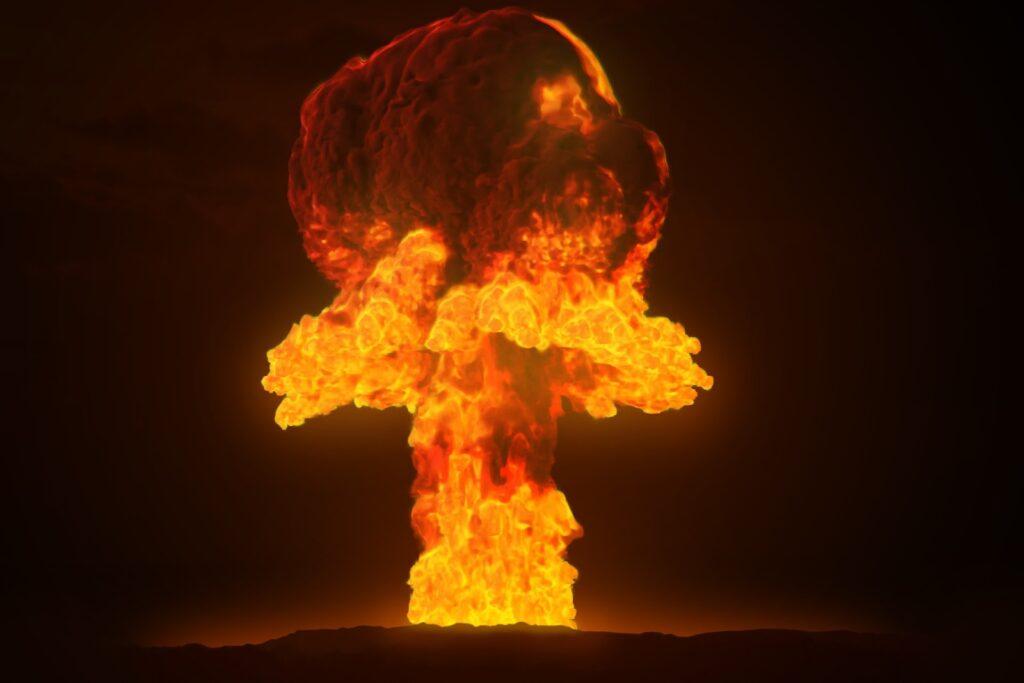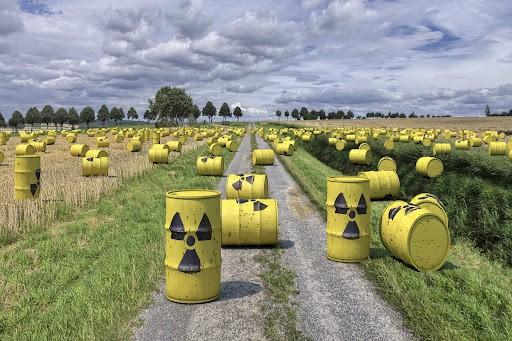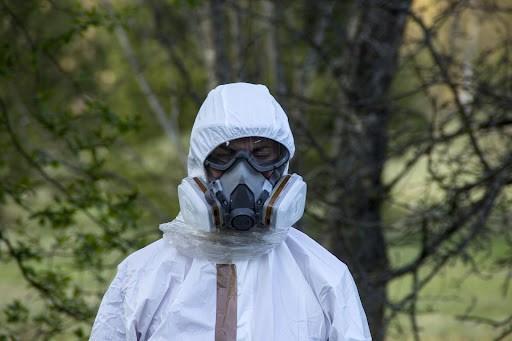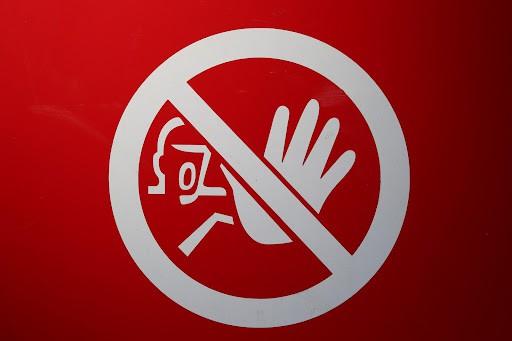If Tsutomu Yamaguchi could survive the bombings of Hiroshima and Nagasaki and live up to the age of 93, surviving the radiation from a nuclear explosion is possible for anyone. Knowing what to do and being prepared gives you a better chance of preventing significant radiation exposure.
But first, understanding the stages of a tactical nuclear bomb explosion is vital to keeping safe.

Three Stages of Nuclear Explosion
Knowing what you’re supposed to avoid helps keep you safe. All nuclear blasts are characterized by the following stages:
First Stage: Ignition
A sudden flash of light, brighter than the sun, appears in the sky. You must run for cover immediately and turn your face away.
The brightness suddenly vanishes, only to return shortly afterward to continue. The competition between the fireball and shock wave causes this distinctive double flash that gets extremely hot and bright. At this point, shielding your eyes is vital to avoid retina burns.
It would be best to wear pale-colored clothes or stay indoors, as the intense thermal radiation can penetrate your clothing and cause skin burns.
There are substantial doses of gamma rays, neutrons, and X-rays that comprise invisible nuclear radiation. Finding cover is essential for shielding from extreme heat and radiation.
These are the first few seconds of a nuclear detonation, and if you’ve survived this far, it implies you’re not at ground zero but on the periphery.
Second Stage: The Blast Wave
This stage starts with an overpressure shock wave and an outward blast wind, consisting of reverse winds returning towards ground zero. Based on the yield and height of the blast, it is most likely that structures within the radius of the epicenter might get destroyed or damaged.
While you’re not in the situation to analyze the statistics at that moment, for better understanding, a one kiloton bomb typically has a fireball radius of approximately 50 meters, causing severe damage 400 meters around.
With the shock wave traveling faster than the speed of sound, considering you’re about one kilometer away from the epicenter, you’ll have to find cover in less than three seconds. It is essential that you’re shielded from thermal and nuclear radiation, as exposure to this could lead to death.
Take shelter indoors, preferably in a reinforced basement or bunker. If the structure doesn’t have one, go for the central portion of a brick or concrete house or a small bathroom at ground level. You could also lie beneath a sturdy table or stay next to a bed or sofa. Being under a bed or sofa could crush you if the concrete slab crashes. Keep in mind to stay away from doors and windows.
The reflection of the incoming shock wave off the internal walls superimposes the original, thus doubling the pressure. So while avoiding the side of the building that’s going to face the explosion, you must lie face down rather than standing.
For those in an apartment building, the fire staircase at the building’s structural core would be the safer option. Structures that are prefabricated or made of timber or fiber cement are most definitely going to crash; hence taking shelter in these structures must be avoided.
Also, keeping your jaw open will distribute the pressure on both sides of your eardrums as the blast comes through.
Third Stage: Radioactive Fallout

This lasts for hours post-explosion, possibly days. During the blast, a cloud of toxic radioactive particles gets uplifted by the wind and contaminates everything in its path, up to hundreds of square miles from the blast site. Being exposed to the fallout could lead to a short life.
Sheltering in place for a few days might be needed if you happen to be in a stable structure like a basement or fire staircase. However, if the building has been destroyed, move into a nearby intact structure sooner.
Keep all the doors, windows, and vents covered. Water from intact pipes and food from sealed cans can be consumed.
If you need to step outside for some emergency, any PPE must be used – including a dust or P2 mask. With tactical nuclear weapons meant to destroy personnel and infrastructure, the troop movement continues under the blast’s cover. Although there is a significant radiological hazard involved, it’s survivable.
However, a radiological weapon causes a deliberate and lethal increase in radiation dose.
Upon moving into a stable shelter, decontamination is required. This involves scrubbing your skin, hair, and nails and discarding the contaminated clothing while changing to clean clothing. Severe burns need to be treated first. It’s likely that by then, rescue and medical treatment will be conducted by national authorities.
Before The Nuclear Blast
With an imminent nuclear attack, finding shelter must always be the priority. Brick or concrete buildings are the best options, with basements or the middle of a large building being equally effective.
Once inside, stay there for 24 hours or until the local authorities update with further instructions on evacuation. Pets must also be kept inside.
If your family members are scattered in different places, let them stay where they are, rather than going about looking for them. You can reunite with them after the nuclear fallout stage.
Being Prepared
If you happen to be in a war zone experiencing the possible use of nuclear bombs, it will help to be prepared as much as possible.
- Identify possible shelter locations close by to where you spend most of your time, preferably underground or in the middle of larger buildings.
- Do not consider open outdoor areas, vehicles, or mobile homes for shelter during a detonation. Basements or the central portion of large multi-story buildings are safer options.
- Keep an emergency supply kit in places that you frequent and possibly have to stay for more than 24 hours. Things to include in this kit are:
- food supplies that will last for three or more days
- bottled water
- battery-powered radio and a spare set of batteries
- a flashlight
- a first aid kit
Surviving During

If there has been a warning of a nuclear weapon attack, immediately find shelter in the closest building and keep away from the windows. This helps in staying protected from the resulting heat and radiation.
In the unfortunate chance that you happen to be outdoors when the detonation occurs, your only option is to take cover behind anything that could offer protection. Lying face down will help protect the exposed skin. If you happen to be in a vehicle, park safely, and stay low.
Once the shock wave has passed, you’ll have about ten minutes or more before the fallout to find a shelter location nearby. Try to get indoors before the fallout arrives as the outdoor radiation levels are highest as soon as the fallout occurs and decreases with time.
Emergency response officials will keep updating with instructions in such times, with advice to possibly evacuate, along with information on routes, shelters, and procedures. Staying tuned will keep you updated on the same.
Staying Safe After
If you are outside after the fallout arrived, you’ll need to follow these steps once you’ve gotten inside any shelter:
- Try avoiding touching your mouth, eyes, and nose as much as possible. Remove the outer layer of your contaminated clothing to avoid prolonged radiation impact on your body.
- Wash thoroughly with soap and water to remove fallout from exposed skin and hair. If washing or showering isn’t possible, wipe with a clean, wet cloth; avoid using disinfectant wipes.
- If your pets were outside after the fallout arrival, gentle brushing of the pet’s coat will remove surface fallout particles. If possible, follow with a soap and water wash.
- Packaged food items or items inside the building are safe for consumption. However, consuming food or liquid that has been outside is most likely contaminated by the fallout and is best avoided.
- If you’re injured or sick, you could contact your healthcare provider for instructions or listen to authorities who will inform you how and where to seek medical attention once it is safe to exit.
Associated Hazards

The different stages of nuclear explosions cause several hazards:
- The initial bright flash could result in temporary blindness lasting for less than a minute.
- The blast wave and the accompanying fire and heat cause death, injuries, and structural damage up to several miles.
- Radiation sickness results from large exposure to radiation, which also damages the body’s cells.
- The electromagnetic pulse may damage electrical and electronic equipment within several miles from the detonation site, causing temporary power disruptions.
Conclusion
The use of nuclear weapons isn’t uncommon for countries at war. While it’s going to lead to destruction and loss of lives, you can follow specific guidelines to keep safe from the blast and minimize the harmful impact of the radiation.
Being caught unaware amid a nuclear war is unfortunate, but with the right information and a few minutes of warning, there are better chances to survive a nuclear explosion.
